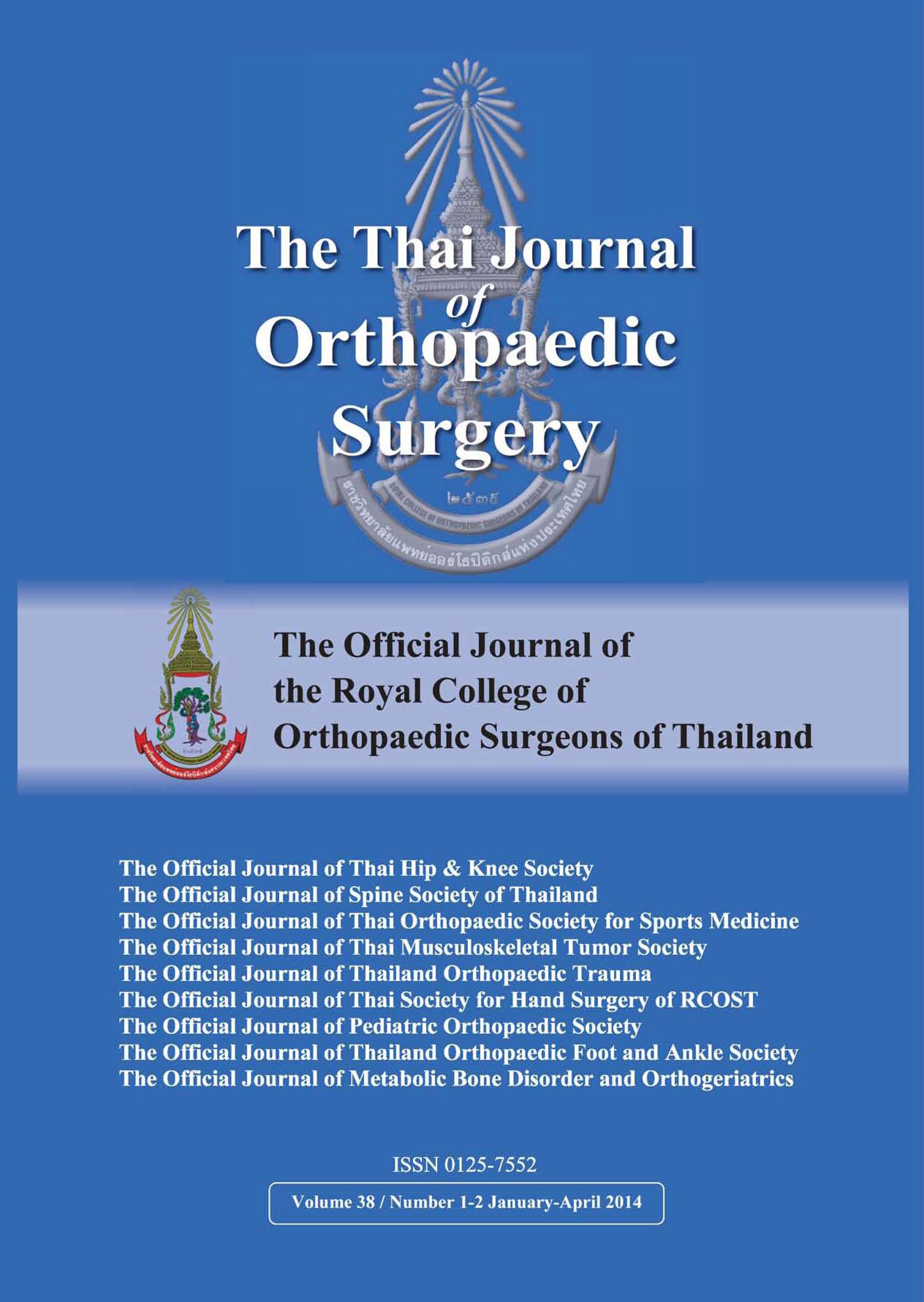Association between the Size of Humeral Head Cysts and the Extension of Rotator Cuff Tears
Main Article Content
Abstract
Purpose: To evaluate the association between the size of humeral head cysts and the number of rotator cuff tears.
Methods: A retrospective study of 115 patients who had a diagnosis of rotator cuff tear by magnetic resonance imaging (MRI) were reviewed and analyzed. The diameters of the cysts were measured using a calibrated digital caliper. Pearson’s correlation test was used to identify the correlation between the number of rotator cuff tears and the diameter of cysts.
Results: A total of 115 shoulder MRIs from 115 patients were included in the present study. The average diameter of cysts was 6.7±2.9 mm. The average diameter of cysts for the group of one, two and three rotator cuff tendon tears was 6.2±3.0, 7.2±2.7, and 7.8±2.9 mm, respectively. There was no statistically significant difference of cyst diameters between the groups of rotator cuff tears. There was no statistically significant correlation between cyst diameters and the number of rotator cuff tears (r = 0.2, P = 0.1).
Conclusion: There was no correlation between the number of rotator cuff tears and cyst size. However, we observed a trend in which the cyst size was slightly larger when the number of tendon tears increase. This finding indicated that the diameter of subchondral bone cysts might be greater in patients with massive rotator cuff tears. Large humeral head cysts may cause unsecure fixation for suture anchor placement. The orthopaedic surgeon must be aware of and prepare for large subchondral bone cysts during the arthroscopic rotator cuff repair.
Article Details
References
2. Chansky HA, Iannotti JP. The vascularity of the rotator cuff. Clin Sports Med 1991; 10: 807-22.
3. Nixon JE, DiStefano V. Ruptures of the rotator cuff. Orthop Clin North Am 1975; 6: 423-47.
4. Bigliani LU, Morrison DS, April EW. The morphology of the acromion and its relationship to rotator cuff tears. Orthop Trans 1986; 10: 228.
5. Toivonen DA, Tuite MJ, Orwin JF. Acromial structure and tears of the rotator cuff. J Shoulder Elbow Surg 1995; 4: 376-83.
6. Hayes PR, Flatow EL. Attrition sign in impingement syndrome. Arthroscopy 2002; 18: E44.
7. Ouellette H, Labis J, Bredella M, Palmer WE, Sheah K, Torriani M. Spectrum of shoulder injuries in the baseball pitcher. Skeletal Radiol 2008; 37: 491-8.
8. Pearsall AW, Bonsell S, Heitman RJ, Helms CA, Osbahr D, Speer KP. Radiographic findings associated with symptomatic rotator cuff tears. J Shoulder Elbow Surg 2003; 12: 122-7.
9. Wissman RD, Kapur S, Akers J, Crimmins J, Ying J, Laor T. Cysts within and adjacent to the lesser tuberosity and their association with rotator cuff abnormalities. AJR Am J Roentgenol 2009; 193:1603-6.
10. Jin W, Ryu KN, Park YK, Lee WK, Ko SH, Yang DM. Cystic lesions in the posterosuperior portion of the humeral head on MR arthrography: correlations with gross and histologic findings in cadavers. AJR Am J Roentgenol 2005; 184: 1211-5.
11. Denard PJ, Burkhart SS. Techniques for managing poor quality tissue and bone during arthroscopic rotator cuff repair. Arthroscopy 2011; 27: 1409-21.
12. Levy DM, Moen TC, Ahmad CS. Bone grafting of humeral head cystic defects during rotator cuff repair. Am J Orthop (Belle Mead NJ) 2012; 41: 92-4.
13. Fritz LB, Ouellette HA, O'Hanley TA, Kassarjian A, Palmer WE. Cystic changes at supraspinatus and infraspinatus tendon insertion sites: association with age and rotator cuff disorders in 238 patients. Radiology 2007; 244: 239-48.
14. Wright T, Yoon C, Schmit BP. Shoulder MRI refinements: differentiation of rotator cuff tear from artifacts and tendonosis, and reassessment of normal findings. Semin Ultrasound CT MR 2001; 22: 383-95.
15. Zlatkin MB, Chao P. The shoulder. In: Mink JH, Deutsch AL, eds. MRI of the musculoskeletal system. New York, NY: Raven, 1990: 19-84.
16. Resnick D, Niwayama G, Coutts RD. Subchondral cysts (geodes) in arthritic disorders: pathologic and radiographic appearance of the hip joint. AJR Am J Roentgenol 1977; 128: 799-806.

